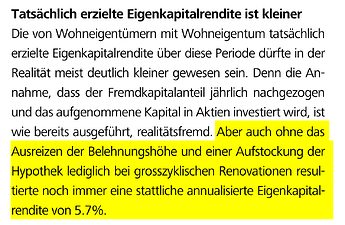Great for you!
I am not saying you shouldn’t look at mortgage cost vs saving in rental cost and what suits your specitific situation. In fact, it should be part of the overall cash flow calculation (which maybe was your point in the first place and I just missed it?).
Anyway, I’m just saying that you can look at the OP question also from a cash flow angle to answer for yourself specifically which approach (or mix of approaches) suits you best.
At the end of the day, IMO, you live your life through cash flows in and cash flows out, not total return of (potentially leveraged) capital gains in X years. YMMV, of course.
To face the potential FOMO painted by the OP, I thus compare myself to myself specifically:
-
the property we rent is valued about CHF 3M (essentially determined by the land price)
- we rent the property for 48k (including Nebenkosten, i.e. total cash flow out)*
- the owner pays for all maintenance & insurance costs. I estimate the maintenance (Unterhalt) to be at at least 10-20k yearly from what I have personally seen getting repaired / fixed / maintained in the past seven years or so; no idea about insurance cost.
-
my (securities) portfolio is valued about the same (or slightly more) as the value of the property
- my portfolio generates cash flow of about 150k per year, growing at a reliable 4-6% CAGR
- portfolio total return rate is at about 15% CAGR over the past 5-6 years
-
remaining income from human capital was about 120k or so in 2024, dropping to about 70k or so starting in 2025
If it was available and we wanted to buy the property we live in, there’s all kind of calculations that can be made: what amount to pay down, how much cash flow is saved in rent, how much cash flow is spent on the mortgage, how much cash flow is spent on maintenance & insurance, how much is cash flow reduced from the slashed portfolio, what does the bank consider as “reliable” income and is that enough to cover the theoretical 5% of financing the mortage, what kind of cash flow do I need for the living standard we want, what amount of down payment to potentially finance from pillar II, what that means for reduced cash flow at the time of withdrawal of pilllar II, etc etc.
In practice, for me specifically, after eyeballing the cash flow numbers I conclude that I want to continue renting.
Kind of what I thought.
My point was more on being able to generate the cash wanted with a market traded portfolio within days, and regardless of time after initial down payment and equity available, versus re-mortgaging again at some later point in time after – I imagine – at least weeks (if not months?) of (re-) negotiations with banks.
* We pay 43k to the owner and about an additional 5k directly to the billers of the Nebenkosten (heating oil, electricity, water, garden, etc). The owner makes a 43k/3000k return on his property ... 1.43% ... minus maintenance and insurance cost.
So probably about one percent. What are current mortgage rates again?
Yikes.
Did I already mention that I love our landlords? May they live forever or at least as long as we rent. 

